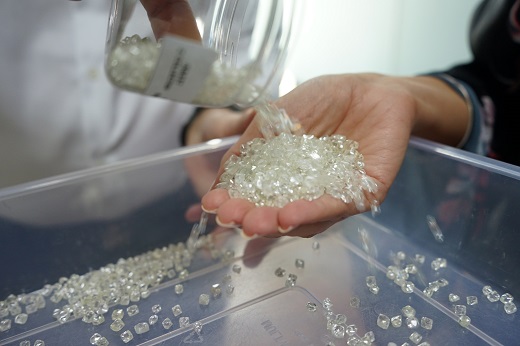|
|
Let’s Set Our Sights on the Auctions
Insights: It’s Time to Break the Rough Supply Cycle
Aug 7, 2019 5:11 AM
By Avi Krawitz
|
|
|

RAPAPORT... De Beers’ first-half earnings highlighted the many challenges facing the diamond trade. But beyond the sharp declines the mining company suffered, CEO Bruce Cleaver and chief financial officer Nimesh Patel were insistent with their messaging: This, too, shall pass.
The executives recognized that the challenges came from within the trade rather than a slump in consumer demand, even as they acknowledged the prevailing macroeconomic uncertainty. They observed that there was excess polished inventory and a shortage of liquidity in the midstream.
De Beers also pointed to retailers’ more conservative approach to inventory management. Jewelers are holding fewer goods in-store and taking more supply on consignment. They’re buying less from diamond manufacturers, which in turn require less rough from the miners.
These developments are not new; they have been evolving since the 2008 financial crisis. Their impact is being felt now because of the excessive volume of rough pushed onto the market in 2017 and 2018. The midstream is under pressure from both the mining and retail ends —
but more so from the mining sector.
More flexibility
Global rough production rose 19% in 2017, or approximately 24.5 million carats, according to Kimberley Process data. That was the year three new mines came onstream: Gahcho Kué, owned by De Beers and Mountain Province; Stornoway’s Renard mine; and Firestone’s Liqhobong operation.
Their timing was unfortunate given the weak market — particularly for Stornoway, Firestone and Mountain Province, which have only one diamond-producing asset each. De Beers, for its part, chose short-term gains in the last two years by selling as many diamonds as it could — with minimal adjustments to rough prices — at a time when midstream inventories were rising and polished prices declining.
Now, De Beers is trying to position itself as a market savior through Cleaver and Patel’s messaging and the “flexibility” the company showed in July, when it allowed sightholders to defer large portions of their purchases until later sales.
But that flexibility is just necessary damage control from its recent excessive supply policy. It’s also worth noting that the miner kept rough prices stable at the July sight, which valued at just $250 million after sightholders “accepted” De Beers’ offer for larger deferrals — more accurately, the buyers refused the goods.
History repeats itself
We’ve seen this pattern before, including De Beers’ assurances that rough sales will return as midstream inventories go down and demand improves around the holiday season. It’s true, the market is cyclical. But these short-term expectations don’t solve the midstream’s long-term profitability problem.
The industry, led by De Beers, has in the past dealt with the glut in the midstream by plugging holes, knowing that more will soon appear. Consider this quote from De Beers’ earnings report for 2015 — the last time rough sales were this low:
“Weaker-than-expected consumer demand in 2015 resulted in retailers reducing their demand for polished diamonds from the midstream manufacturers. A buildup in polished stocks in the midstream put downward pressure on polished prices, and reduced the midstream’s willingness to purchase additional rough diamonds. This was exacerbated by a more stringent financing environment.”
Sound familiar? It’s worth recalling what led to that difficult market environment.
The buildup of polished stock back then came after manufacturers — anticipating continued growth in China — sent large quantities of goods to the Gemological Institute of America (GIA) for grading in 2014. The GIA was not well equipped for those volumes at the time, and large quantities of diamonds became stuck at its labs. Those goods were eventually released to the market in the first half of 2015, while Chinese economic growth slowed and the government’s anti-corruption campaign curbed luxury purchases. The US dollar also strengthened against global currencies, putting further pressure on diamond trading.
De Beers subsequently granted sightholders the “flexibility” to defer goods from the final sights of the year and deplete their excess polished inventories. De Beers’ November 2015 sales sunk to an unprecedented $70 million, while the company kept prices stable.
And then the cycle started again.
Shift to demand
In the three and a half years since, the industry has encountered a ramp-up of rough production, even further bank caution, high-profile fraud carried out by members of the trade, Indian demonetization, a trade war that has slowed Chinese growth, and a strengthening of the dollar. Meanwhile, polished prices have continued to soften and manufacturing profit margins have tightened.
To break the cycle, rough prices need to drop, and supply from the major miners — De Beers and Alrosa — must be less rigid in the long term.
The trade has to stop being controlled from the supply side. It must move away from its reliance on the contract system, in which De Beers sightholders and Alrosa Alliance members pay a premium for the promise of consistent supply but are also under obligation to buy goods at unsustainable prices.
For too long, that system has proven unprofitable. It’s time for the rough sector to shift more of its focus to auctions or tenders, in which the market sets the prices and manufacturers can buy what they need. To ensure the long-term profitable future of the diamond trade (and De Beers), the force driving the rough market must be demand.
Image: Rough diamonds offered on tender at the Dubai Diamond Exchange in July. (DMCC)
An abridged version of this article first appeared in the August 2019 edition of Rapaport Magazine.
|
|
|
|
|
|
|
|
|
|
Tags:
Alrosa, Avi Krawitz, Bruce Cleaver, De Beers, diamonds, Firestone Diamond, Gahcho Kué, Jewelry, Liqhobong, mountain province, Nimesh Patel, Rapaport, RapNet, renard, Stornoway Diamond
|
|
|
|
|
|
|
|
|
|
|

|
|